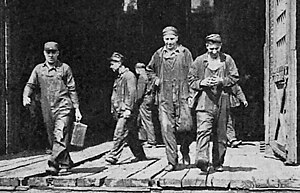Great Railroad Strike of 1922
The Great Railroad Strike of 1922, commonly known as the Railway Shopmen's Strike, was a nationwide strike of railroad workers in the United States. Launched on July 1, 1922, by seven of the sixteen railroad labor organizations in existence at the time, the strike continued into the month of August before collapsing.
At least ten people, most of them strikers or family members, were killed in connection with the strike. The collective action of some 400,000 workers in the summer of 1922 was the largest railroad work stoppage since the American Railway Union's Pullman Strike of 1894 and the biggest American strike of any kind since the Great Steel Strike of 1919.
During American participation in World War I, the American railroad system, the primary mode of freight and passenger transportation in the era, was nationalized by an executive order by President Woodrow Wilson. Operation of the railways was turned over to an institution known as the United States Railroad Administration. A period of relative labor harmony followed, marked by the establishment of the 8-hour day across the railroad industry.
This interval of labor peace proved short-lived, however, following return of control of the rail system to private hands by the Transportation Act of 1920. A new bureaucratic entity for coordination of the industry was created at this time, a 9-member panel known as the Railroad Labor Board. This body was given the power to oversee the wages and working conditions of more than 2 million American railway workers.
The war years had been a period of dramatic inflation across the American economy. Price levels began to turn the other direction in the first years of the 1920s as increased wartime demands upon production were regularized and labor supply was expanded with the reintegration of millions of former soldiers into the employment market. In response to the hanging economic conditions, railway companies obtained approval from the Railroad Labor Board in 1921 for deep reductions in wage rates for workers across the industry.
...
Wikipedia

